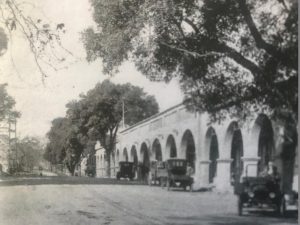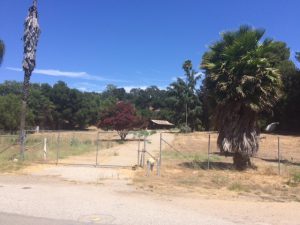The following article first appeared on the front page of the Friday, August 18, 1916 edition of “THE OJAI.” The author is unknown. Note: Reference is made several times to the town of “Nordhoff.” This was what the town’s name was before it was changed to “Ojai”. All photos were added to this article by the Ojai Valley Museum.
THE TRANSFORMATION HAS BEGUN
Just now things are doing in Nordhoff of such unusual character that the oldest inhabitant is constrained to sit up, or stand up, and take notice. In fact, the activity is being led by one of the oldest inhabitants — Thomas Clark, who, indeed, throughout all the past in Nordhoff’s history, has lived an active life, contributing his full share of the warp and woof woven into history’s fabric, which has grown threadbare in spots by the constant wear of time, and which he has started in to rehabilitate with new industrial threads and some patches.

No doubt the inspiration for greater and better things first surged in on the crest of the wave of sentiment for good roads, becoming a fixed purpose when Mr. E. D. Libbey arose to the occasion and gave added impetus to the vehicle of progress not alone in words, but in action. As a captain of industry and commercial achievement few men are better equipped than Mr. Libbey. With the wealth to humor any reasonable ambition, coupled with an inclination favorable to this locality. Nordhoff is indeed fortunate to have the right to lay partial claim to the citizenship of such a magnanimous benefactor and admirer of nature’s gifts so lavishly, of which Nordhoff is the commercial center.
Mr. Clark’s labors for betterments are closely linked with Mr. Libbey’s plans for civic or community improvements, the work of the former aiding the purposes of the latter, which are known to and being carried out by Mr. H. T. Sinclair. Mr. Libbey’s confidential agent in the matter of improvements contemplated or in progress on the beautiful park tract and the old Ojai Inn square, which is the expansive front yard or plaza of the business center of Nordhoff, to be transformed into a place of greater beauty by the hand of artifice, and to harmonize the scene, without a blemish, the property owners will obscure unsightly fronts behind an ornamental arcade of concrete and tile, the material for which already lines either side of the street, awaiting the labors of the architect and the builders.

After some parleying, and a small amount of worry as to the fate of the postoffice, Tom Clark cleared the way for a place for the old postoffice building to light, and Escovedo, the housemover, accomplished the rest, and the old Smith building has been transplanted — in two sections — across the street, and now rests intact on the east side of the Clark lot, with post office, plumbing shop, barber shop and Brady’s kitchen safely housed as of yore.

To do this Mr. Clark wisely revised his plans and demolished his entire barn structure, to be replaced with a modern garage and auto and horse livery annex. The west wall of the garage, under the skilled hand of Philip Scheidecker, of Los Angeles, is rapidly going up, entirely constructed of rock, mostly moss-covered, above the rougher foundation.

The removal of the old building is the signal for activity on the Libbey side, but just what transformation is to take place is a matter of rumor or conjecture. A fine building, without doubt, is to replace the old, combining post office and public library — perhaps. Many other things are likely to happen that will add to the greater and more beautiful Nordhoff.




